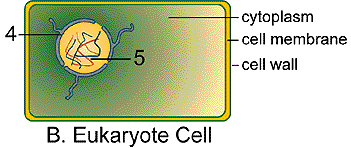
Prokaryotic cells - These cells do not have their genetic material enclosed within a membrane-bound nucleus and also lack other membrane-bound organelles, the DNA is in a single circular form. Bacteria and cyanobacteria (blue-green algae) are examples of prokaryotic cell types.
In your notes draw and label the picture below choosing the correct terms from the following list: circular DNA, chromatin, cytoplasm with ribosomes, nuclear membrane, nucleoplasm, cell wall or cell membrane.

7. Label the above cell structures
Click here to check your answers.
Eukaryotic cells - These cells have their genetic material enclosed
within a double membrane (bound nucleus) and contain membrane-bound organelles,
the DNA is in a linear thread form. In a normal body cells of higher organisms
these DNA molecules are present in pairs (diploid cells). They are not
in a circular form like that of the prokaryote cells. In the picture below
there are six DNA molecules (two sets), the three red ones are one set
of different lengths and the three green ones are the second set with different
lengths that match up to the lengths of the first set. When a cell prepares
for cell division each DNA molecule will take on the form of a single chromosome.
In your notes draw the cell below with its six DNA molecules
in the arrangement described above and label four and five.

8. Label the above cell.
Press here to check your answer.
Chloroplasts - organelles found in plant cells; site of photosynthesis;
surrounded by a double membrane and containing an extensive internal membrane
system bearing chlorophyll. This organelle also contains a circular DNA
molecule similar to the DNA found in prokaryote cells. Study the figure
of a chloroplast found in the G-1
readings. Draw this figure in your notes and identify six.

8a. Label the above organelle Press here
to check your answer.
Mitochondria - organelles of both plant and animal cells; site of cellular
respiration; surrounded by a double membrane containing an extensive internal
membrane system containing enzymes for respiration. This organelle also
contains a circular DNA molecule similar to the DNA found in prokaryote
cells. Study the figure of a mitochondrion found in the G-1
readings. Draw this figure in your notes, label and identify seven.

9. Label "7" in this this organelle.
Press here to check your answer.
10. Which of the following replicate(s) by binary fission?
- a) chloroplast
- b) mitochondrion
- c) eukaryote cell
- d) prokaryote cell
- e) a, b and d
11. Which of the following does not contain circular DNA?
- a) mitochondria d) prokaryote cells
- b) chloroplasts e) a, b and d
- c) eukaryote cells
12. Which of the following has a double membrane surrounding the DNA?
- a) mitochondria
- b) chloroplasts
- c) eukaryote cells
- d) prokaryote cells
- e) none of these
This is the end of lesson one. Please answer the following question
correctly to go to the second lesson Eukaryotic Nucleus.
13. Are the organelles chloroplasts and mitochondria self replicating?
For information on how to use this page, go to How to Use This Site.
Created by the Center for Learning Technologies, Academic Technology Services.
Last modified October 22, 1997.